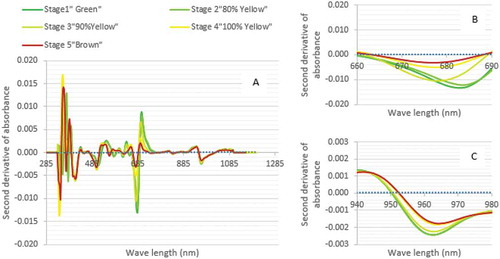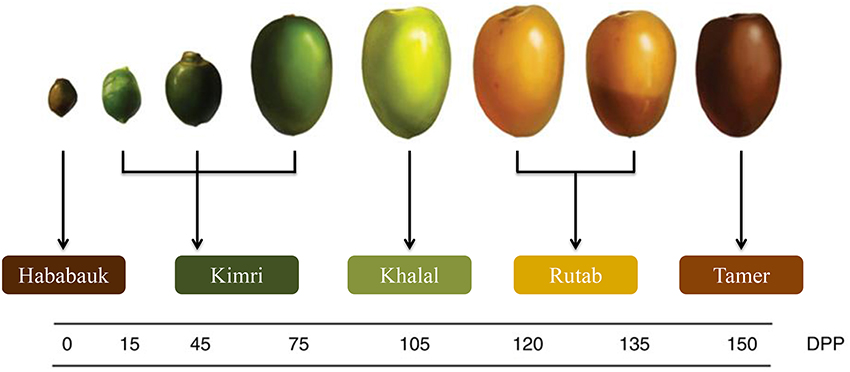October 21, 2020 at 9:23 pm | Updated October 21, 2020 at 9:23 pm | 6 min read
NIR spectroscopy is replacing older, more destructive methods of analysis to detect chemical and physical characteristics in date fruits. Modern NIR spectrometers that are portable and small have extended the application of this technology to farms, storage facilities, and retail markets. The new devices provide a rapid, accurate, and easy method to assess quality, chemical composition, and maturity of date fruits.
NIR Spectroscopy
Near-infrared (NIR) spectroscopy is being used in agriculture to improve the quality of produce in many ways. Near-infrared lies in the range 760 and 2500 nm and is part of the invisible light spectrum.
It is suitable to identify organic compounds and the quantities in which it is present. When NIR light is directed at samples, the light stimulates the compounds in it, causing them to vibrate at characteristic frequencies. Energy from the light is differentially absorbed, transmitted, and reflected by the compounds. This process is used to identify the compound. The interactions of light with the sample are specific to a compound and the molecular bonds holding it together. So, each compound needs a specific wavelength of NIR for detection, as shown in Figure 1.
Subscribe to the Felix instruments Weekly article series.
By submitting this form, you are consenting to receive marketing emails from: . You can revoke your consent to receive emails at any time by using the SafeUnsubscribe® link, found at the bottom of every email. Emails are serviced by Constant Contact
For example, the wavelengths of NIR used in date fruits are
- 660-690 nm to detect chlorophyll.
- 940-980 nm for moisture content measurement.
- 285–1200 nm to grade maturity, based on soluble solid content and water.

Figure 1. “(A) absorbance for chlorophyll wavelength range (660-690 nm) and (B) absorbance for water content wavelength range (940-980 nm). (C) for each Barhi fruits stage of maturity.” (Image credits: doi/full/10.1080/10942912.2017.1387794)
NIR Spectroscopy for Date Palms
The date palm (Phoenix dactylifera L.) is one of the oldest fruits produced in the world. Dates are one of the major crops grown in the Middle East, Asia, and Africa, and the livelihoods of many people depend on date farming. There are more than 400 varieties of date fruits in Iran alone.
Date fruits are berries, with a single seed. The final size and color of the fruit skin can vary depending on the variety and region of cultivation.
NIR is being used to detect chemical composition. It can also quantify sugar or soluble solids content (SSC) by Brix. Spectroscopy is also used in detecting the physical characteristics of date fruits.
NIR spectroscopy replaces the destructive and chemical methods that are normally used. Estimation of soluble solid content is difficult in date fruits because it lacks juices. Here, NIR technology provides date farmers and producers an extra advantage.
We will discuss how and when NIR spectroscopy can be applied in the production of date fruits.
Chemical Composition
The date fruit is very nutritious and also considered to have medicinal value. It is rich in nutrients (such as carbohydrates, fats, proteins, vitamins, and minerals) and phytochemicals (like carotenoids, polyphenols, sterols, and tannins). Hence, quality control is not the only reason to estimate the chemical composition of this fruit.
The chemical composition of fruit changes depending on the variety, maturity at harvest, storage conditions, and post-harvest processing, as well as the geographical location and farm soil conditions.
Maturity Index
Dates do not ripen evenly within a crop. In a few varieties, ripening starts early in summer and continues until the end of the season in August and September. At each stage of maturity, there are considerable differences in the physical and chemical properties of the fruit.
The quality parameters of soluble solid content (SSC) and moisture content are used as maturity index in date fruits. There are four ripening stages in date fruits, along with a pre-maturation stage (See Figure 2). Scientists have specified the quality parameters for each of the ripening stages using NIR spectroscopy.
The five stages of maturity in date fruits are as follows:
- Hababauk: This is the pre-maturation stage, and the date fruits have not attained their final size.
- Kimri: Fruits are green with high moisture content and low sugar levels.
- Khalal or Kharak: The skin of the dates starts to change color to red or yellow, and sugar content increases.
- Rutab: The dates become softer and brown and have higher sugar content.
- Tamer: In the final stage, the date fruits are brown to black with little moisture content but high sugar concentration. This makes it easier to store them longer at room temperatures.
Farmers can easily use NIR spectrometers to apply the research findings in their field to measure maturity.

Figure 2: “The five growth stages of a date fruit by days post pollination (DPP) (Al-Mssallem et al., 2013).” (Image credits: doi: 10.1038/ncomms3274).
Sorting
Sorting fruits based on their maturity can help producers in several ways, such as
- Optimizing Harvest Time: Some varieties, like Barhi dates, have a short harvest period of three weeks. Khalal, or the third ripening stage when the fruits have turned yellow but are not completely ripe, is considered the ideal time to harvest them. NIR spectrometers can help to find them when most of the crop is in this stage. Harvesting crops at this stage can optimize post-harvest quality.
- Grading Harvest: In many places, fruits are harvested only once in the season for economic reasons. Hence, the harvest includes date fruits in different stages of ripening. NIR spectrometers can separate and grade the date fruits on the farms according to their maturity.
- Choose Markets: Farmers can decide where and how to sell their products based on fruit maturity. Ripe fruits can be sold locally, while less mature fruits can be exported or stored in cold storerooms or controlled environments.
Grading machines with attached NIR spectrometers are already available for large-scale production. Small-scale producers can use equally efficient portable NIR tools in the whole supply chain.
Sugar Content
The main criteria used to decide fruit quality is sugar content. NIR spectroscopic models, combined with multivariate calibration, can predict the sucrose content of whole fruit samples by measuring Brix.
- Sweeter varieties with thirty-six to sixty percent sucrose are Ajwa, Almadina, Barnia, Nizwi, Khalas, Maan, and Khunizi.
- Less sweet varieties with only three to eight percent sucrose are Fardh, Nashu, Naghal, and Qash Tabaq.
Post-Harvest Quality Control
Besides chemical quality parameters, like sugar and water content, physical conditions of dates can also be good predictors of their quality during harvest and storage.
Here again, NIR spectroscopy can take the guesswork out of describing sensory and textural parameters. It provides a method that is objective and can be used even by untrained or inexperienced staff.
NIR spectrometers can predict hardiness, cohesiveness, and chewiness for the three maturity stages of Kimri, Khalal, and Rutab. It can also detect the changes that occur in the fruits due to different storage methods, such as low temperature and controlled environment conditions.
Also, people can use these parameters to
- sort fruits to decide market destinations.
- predict the shelf life of date fruits.
Disease Control
Manually spotting diseases in fruits is difficult, and people have to rely on visual symptoms.
Microbial infection alters the chemical composition of date fruits. NIR spectroscopy can detect these changes in chemical composition to provide early warning. People can then remove damaged ware and protect the rest of their products. For example, NIR spectroscopy can successfully predict date contagion by the fungus, Aspergillus flavus.
However, the changes in fruits by each microbe will vary. Moreover, various varieties can react differently to the same microbe. So, more studies are needed to build NIR spectroscopy models for the other pest and disease attacks.
Produce Quality Meter
Felix applied Food Science Instruments produces many quality meters for rapid and non-destructive fruit analyses. Its F-750 Produce Quality Meter uses NIR spectroscopy. The F-750 is a small, handheld device that is popularly used for a wide range of fruits and vegetables around the world. It can measure soluble solid content (Brix), moisture content, titratable acidity, and color. Accompanying instructions make it easy to create models for new fruits and varieties, so the F-750 is a very versatile tool for any fruit producer.
—
Vijayalaxmi Kinhal
Science Writer, CID Bio-Science
Ph.D. Ecology and Environmental Science, B.Sc Agriculture
Feature image courtesy of Abdulla Al Muhairi
Sources
Al-Alawi, R. A., Al-Mashiqri, J. H., Al-Nadabi, J. S. M., Al-Shihi, B. I., & Baqi, Y. (2017). Date Palm Tree (Phoenix dactylifera L.): Natural Products and Therapeutic Options. Frontiers in Plant Science, 8. doi: 10.3389/fpls.2017.00845
Alhamdan, A. M., & Atia, A. (2017). Non-destructive method to predict Barhi dates quality at different stages of maturity utilising near-infrared (NIR) spectroscopy. International Journal of Food Properties, 20(sup3). doi: 10.1080/10942912.2017.1387794
Alhamdan, A. M., Fickak, A., & Atia, A. R. (2019). Evaluation of sensory and texture profile analysis properties of stored Khalal Barhi dates nondestructively using Vis/NIR spectroscopy. Journal of Food Process Engineering, 42(6). doi: 10.1111/jfpe.13215
Al-Mssallem, I. S., Hu, S., Zhang, X., Lin, Q., Liu, W., Tan, J., et al. (2013). Genome sequence of the date palm Phoenix dactylifera L. Nat. Commun. 4:2274. doi: 10.1038/ncomms3274
Mabood, F., Al-Harrasi, A., Boqué, R., Jabeen, F., Hussain, J., Hafidh, A., … Hamood, S. A. (2015). Determination of sucrose in date fruits (Phoenix dactylifera L.) growing in the Sultanate of Oman by NIR spectroscopy and multivariate calibration. Spectrochimica Acta Part A: Molecular and Biomolecular Spectroscopy, 150, 170–174. doi: 10.1016/j.saa.2015.05.040
Mireei, S.A., Mohtasebi, S.S., Massudi, R., Rafiee, S., Arabanian, A.S., and Annachiara Berardinelli, A. (2010). Non-destructive measurement of moisture and soluble solids content of Mazafati date fruit by NIR spectroscopy. AJCS 4(3):175-179. Retrieved from https://mireei.iut.ac.ir/sites/mireei.iut.ac.ir/files/file_pubwdet/published_ajcs.pdf
Teena, M., Manickavasagan, A., Ravikanth, L., & Jayas, D. (2014). Near infrared (NIR) hyperspectral imaging to classify fungal infected date fruits. Journal of Stored Products Research, 59, 306–313. doi: 10.1016/j.jspr.2014.09.005
Related Products
- F-751 Grape Quality Meter
- Custom Model Building
- F-910 AccuStore
- F-751 Melon Quality Meter
- F-751 Kiwifruit Quality Meter
- F-750 Produce Quality Meter
- F-751 Avocado Quality Meter
- F-751 Mango Quality Meter
- F-900 Portable Ethylene Analyzer
- F-950 Three Gas Analyzer
- F-920 Check It! Gas Analyzer
- F-960 Ripen It! Gas Analyzer
- F-940 Store It! Gas Analyzer
Most Popular Articles
- Spectrophotometry in 2023
- The Importance of Food Quality Testing
- NIR Applications in Agriculture – Everything…
- The 5 Most Important Parameters in Produce Quality Control
- Melon Fruit: Quality, Production & Physiology
- Fruit Respiration Impact on Fruit Quality
- Guide to Fresh Fruit Quality Control
- Liquid Spectrophotometry & Food Industry Applications
- Ethylene (C2H4) – Ripening, Crops & Agriculture
- Active Packaging: What it is and why it’s important






